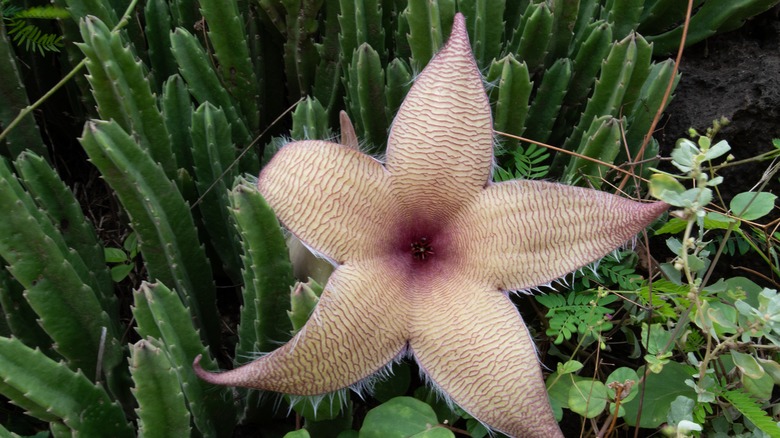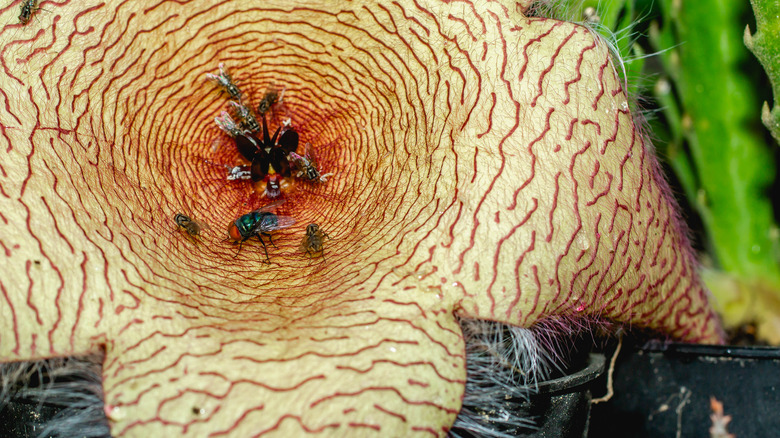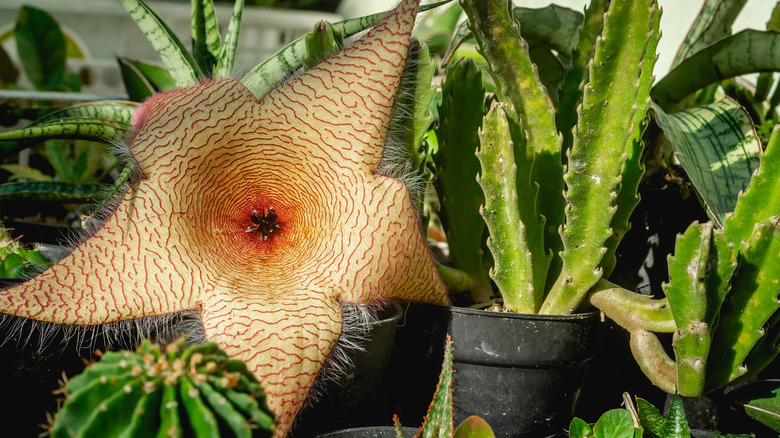Zulu Giants Are Beautiful Flowering Cacti You Should Think Twice About Planting
A picture may be worth a thousand words, but with Zulu giants (Stapelia gigantea), what you see is not quite what you get. The stunning flowers of this succulent resemble starfish with their five-pointed shape in yellow and pink hues. While their aesthetic is unique and desirable, it's important to note that there are a few cons to growing Zulu giants. One of the most obvious drawbacks of growing these succulents is that they give off a very unpleasant odor, and in some parts of the world, they are even invasive.
Zulu giants, also called giant toad plants, carrion plants, and starfish plants, are native to southern and tropical regions of Africa. They consist of thin, vertical cactus stems and large, vibrant flowers that bloom in the fall and can measure up to 14 inches wide. The stems may be green or purplish. These plants require a warm habitat and are only hardy in USDA zones 9a to 11b. They can be grown indoors or in greenhouses and do well in clay pots. Succulent soil with great drainage is essential, and in the winter months, these plants should not be watered at all. It's best to place Zulu giants in full or partial sun.
Drawbacks of planting Zulu giants
A few unique aspects of Zulu giants make them undesirable for many gardeners and households. Most notably, they stink ... literally. As the nickname "carrion plant" suggests, these flowering succulents smell like death and decay in order to attract beetles, flies, and other carrion feeders that the flowers need for pollination. Their flowers even feature small hairs to mimic a dead animal's texture. While this is a fascinating evolutionary feature, it's a significant downside if you're looking for a showy succulent to plant inside your house or near your patio. Both due to the bugs they attract and the stench itself, you should stay away from this species of cacti in your home.
Another important consideration when deciding whether Zulu giants are the right fit for your plant collection is their invasive nature in some environments. While they are not considered invasive in North America, Zulu giants can spread in arid, island-like climates when left unchecked. If you live somewhere that fits that description, you'll want to avoid growing the invasive species in your yard. A final drawback to planting Zulu giants is that their sap can cause skin irritation, so it's important to wear gloves when handling them. For households with curious pets or children, the risks of having this plant around might outweigh the benefits, and it may be best to choose another option from a list of cacti you should grow that bloom with colorful flowers.
Benefits of planting Zulu giants
If the odor doesn't bother you and you don't live in a climate where your Zulu giant plants could become invasive, there are plenty of reasons to add this unique species to your collection. The most obvious motivator for growing this plant is that it's very interesting to observe, from its pollinator attraction strategy to the bulbous flower petals themselves. Because their odor is designed to attract beetles and flies, they can help boost the food supply for birds, lizards, and other wildlife in the process.
On top of drawing in food sources for birds and reptiles, Zulu giants are also extremely easy to grow in the right climate. As succulents, they are tolerant to drought, so you won't see your water bill spike when you add them to your yard. They can grow in well-drained soil in the ground, in hanging baskets, or in clay pots. Their biggest threats are overwatering and mealy bugs. They're easy to propagate using stem cuttings, so you can spread or share them to your heart's desire.


